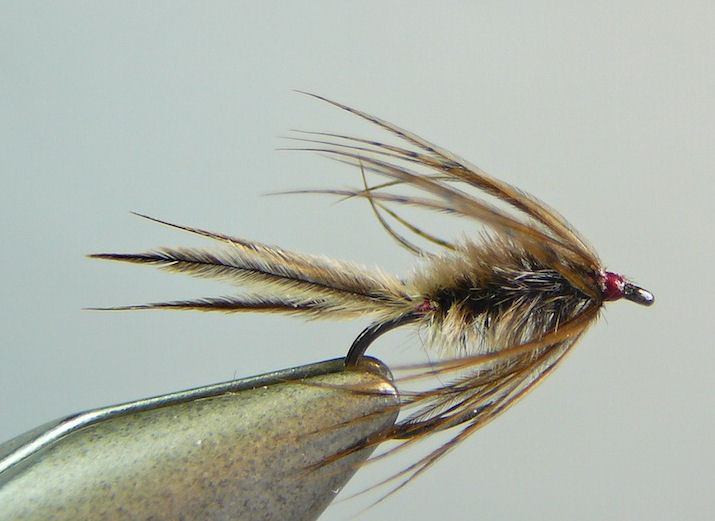
On The Fly
August 2012
"Fly tying is a school from which we never graduate"
TYING NEWS
The Southern Oregon Fly Tyers invite you to attend their meetings the second Tuesday of
each month. The next meeting is September 11, 2012. The meetings start at 6:00 PM, at the Madrone Hill
Mobile Home Park community building near Gold Hill. Bring a friend, come early so you don't miss
anything, and stay late. Tyers need not be experienced, and those with all levels of skill are
welcome. Each meeting a member is encouraged to demonstrate a new or different skill, from simple
to difficult. For more information, call Dan Kellogg at 773-4724.
There won’t be any SOFT functions during July & August. We'll start back up again in September.
DIRECTIONS: Take Gold Hill Exit #40, off of I-5 and go west, toward Jacksonville, 1.3 miles, until you
reach the brick entrance way to the Madrone Hill Mobile Home Park on the right. You’ll pass a golf course
parking lot on your left shortly after leaving the freeway. After you turn right into the
mobile home park, proceed to the community building which is located about 100 yards ahead on the left. The
address is 8401 Old Stage Rd. Please park your vehicle on the bare dirt in the parking lot to avoid the
wooden septic covers in the grass
 PATTERN OF THE MONTH –Stillwater Siren
PATTERN OF THE MONTH –Stillwater Siren
Hook: Daiichi 1530, 2x long wet, size 14 to 20.
Thread: 8-0 red.
Tail: Natural ostrich herl tips.
Body: Natural ostrich herl twisted with fine wire.
Hackle: Partridge dyed brown.
Tying Instructions:
Step 1: Mash the barb and mount the hook in the vise.
Step 2: Start the thread just behind the hook eye and lay down a thread base rearward to the point just above
the hook barb.
Step 3: Select 3 ostrich herls, even the tips, measure for one shank length, and tie in as a tail on top of
the shank, just above the hook barb. Do not trim the excess ostrich herls
Step 4: Cut a length of fine wire and tie it in on top of the hook at the base of the tail. The excess
should be pointing toward the rear.
Step 5: Grab the 3 herls and the wire and take one wrap over the hook shank at the base of the tail then
grab the herl tips along with the wire in your hackle pliers and twist them into a loose rope. Wind the
rope forward in touching turns to a point one eye width behind the hook eye. Tie off and trim excess.
Step 6: Select a partridge feather with barbs long enough to reach the base of the tail. Prepare the
feather and tie it in by the tip. Take two turns stroking the barbs to the rear on each half turn. Secure
with thread wraps and trim the excess.
Step 7: Form a neat small head, whip finish, and cement.
My research on the Stillwater Siren did not reveal the inventor of the pattern but did
enlighten me about the importance of the aquatic insect it was suppose to imitate, the Callibaetis emerger.
There is no insect more important to the western Stillwater angler than the Callibaetis Mayfly and here's
why. No bug dominates more stillwaters. It is highly tolerant of ecological extremes and can inhabit the
worst of conditions but thrives in the best conditions. The Callibeatis is available 365 days a year and
it predictably hatches throughout the entire fishing season. It acts in predictable ways and trout key in
on that predictability. It is a member of the Baetidae family of mayflies who are multi brooded which means
they mature very fast and several generations will emerge in a single season.
As the majority of nymphs drift up from the weeds and converge on the surface, so do the
trout, Here the feeding is easy, and at times gluttonous. The fish disregard the nymphs and duns to feast
on the hapless emergers. The emergers can neither swim or fly away and the trout feed at their leisure. This
months pattern, the Stillwater Siren, does a great job of imitating this vulnerable stage. The natural has
a slender body with three equal length tails that are as long as the body. Gill fringes each flank of the
abdomen. The sweeping antennae are over twice as long as the head is wide. Those features describe the
Siren very closely and the soft hackle adds life and movement to the deception. The trout don't seem to be
too picky when it comes to coloration of the artificial. Matching the bottom's natural hues seems to be
universally accepted by even the most finicky fish. The nice thing about fishing emergers is that exact
size isn't too important. Just keep this in mind, the naturals get smaller as the summer turns to fall
when a size 20 is common.
So the next time you're on your favorite pond or lake and the trout stop hitting on
midges or whatever, have some of these babies in the fly box. More than likely there is a Callibeatis hatch
happening under the surface and the trout are completely distracted by their favorite meal. The Stillwater
Siren is an easy tie using common materials. So tie some up, give them a test flight, and let me know how
you do.
Tie One On,
Dan Kellogg
(you can contact me at FLYGUY@EZNORTHWEST.COM)
www.tyerstoolshop.com